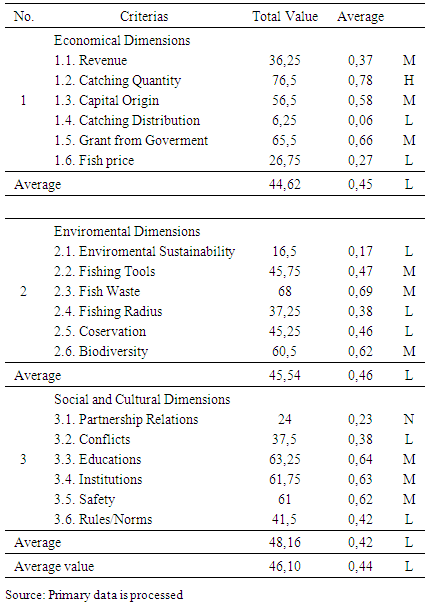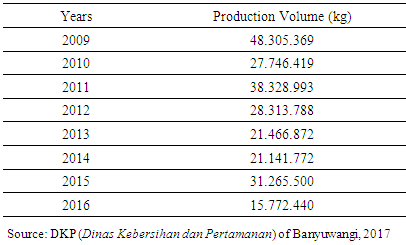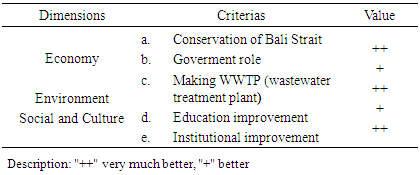-
Paper Information
- Paper Submission
-
Journal Information
- About This Journal
- Editorial Board
- Current Issue
- Archive
- Author Guidelines
- Contact Us
American Journal of Economics
p-ISSN: 2166-4951 e-ISSN: 2166-496X
2019; 9(5): 223-231
doi:10.5923/j.economics.20190905.01

Empirical Studies the Sustainability of the Subsector Fisheries on the Coastal of Regency Banyuwangi (Perspective of Sustainable Development)
Herman Cahyo Diartho
Department of Economics Science, Faculty of Economics and Bussines, University of Jember, Indonesia
Correspondence to: Herman Cahyo Diartho, Department of Economics Science, Faculty of Economics and Bussines, University of Jember, Indonesia.
| Email: |  |
Copyright © 2019 The Author(s). Published by Scientific & Academic Publishing.
This work is licensed under the Creative Commons Attribution International License (CC BY).
http://creativecommons.org/licenses/by/4.0/

Fishery resources in the coastal areas of Banyuwangi has enormous potential in supporting the life of fishermen. However, the current actual condition, the volume of fishery production in the coastal areas of Banyuwangi has decreased. Sustainable development in the fishery subsector is directed to improve the welfare of fishermen, optimizing the utilization of fishery resources without neglecting the economic, ecological (environmental) and social aspects. The results showed that the development of fishery resources in the coastal areas of Banyuwangi has not reached the sustainable stage. The results of the measurement of the sustainability of fishery resources showed low average value. From each dimension (economic, social and environmental) there are several criterias that have medium (M) and high (H) value. This means that in each dimension requires an alternative recommendation to support the sustainable development of capture fisheries. Economic dimension, the decline of catching quantity is a priority to formulate recommendations. The beneficiaries of fishery resources should provide a compensation for conservation measures to maintain the capture fisheries ecosystem. In addition, the role of the government is also needed as a party that has an important role related to fishery resource policy. The environmental dimension has only one priority of recommendation developments, that is making WWTP (wastewater treatment plant) and its use according to standard. Better waste management can minimize pollution so it will not affect the balance of the ecosystem of fishery resources. Social dimension, institutional system improvement is a recommendation option that can improve the fishery resource management system in coastal areas of Banyuwangi to improve the prosperity of fishermen. Finally, improvements in every aspect of supporting sustainable fisheries development can maintain the sustainability of fishery resources so that the utilization of capture fisheries resources can be done optimally without putting aside the economic, environmental and social sustainability.
Keywords: Capture Fishing Subsector and Sustainable Development
Cite this paper: Herman Cahyo Diartho, Empirical Studies the Sustainability of the Subsector Fisheries on the Coastal of Regency Banyuwangi (Perspective of Sustainable Development), American Journal of Economics, Vol. 9 No. 5, 2019, pp. 223-231. doi: 10.5923/j.economics.20190905.01.
Article Outline
1. Introduction
- Resources in the fisheries sector is one of the most important resources for the livelihood of the people and has a potency to be a prime mover of the national economy (Mariani, 2014). This is reflected in the contribution of the fishery sector to the national economy. Based on data from the Ministry of Marine Affairs and Fisheries, in 2016 the potential of capture fisheries in Indonesia reached 9.9 million tons where this number will continue to increase in the next year as the reduction of foreign fishing boats around Indonesia’s sea. This condition occurs because the marine resources that become the source of livelihood of the fisherman is openly accessed. The further impact of open access resources is the first to cause fishermen whose livelihood resources depend primarily on marine and fishery resources often have to move around to obtain maximum catch. Second, the openly accessed livelihood patterns and activities affect the culture, institutions and local wisdom of the fishermen and coastal communities of Indonesia. Along the coast of the Indonesian archipelago, there are a number of different traditions, institutions and local wisdom (Hidayat, 2013). The nature of open access ocean resources often leads to the use of irresponsible or neglect of sustainability preservation because the community assumes that they are free to take the existing resources with no control (Nurhayati, 2013).In fisheries development, the challenge to sustain resources is a complex issue. Fishery resources are categorized as recoverable resources, but the most frequent question is how large the fish can be harvested without having a negative impact for the future. Continuity is a key word in fisheries development that is expected to improve the condition of the fishery community's resources and welfare (Fauzi and Anna, 2002). Fisheries resources are natural assets that are extracted to provide the greatest benefit to human beings. However, this aspect of benefits has various dimensions, both economic, ecological and social dimensions. The complexity of these fish resources leads to the increasingly complex fisheries development objectives (Mariani et al. 2014).The catch of the fish in the coastal areas of Banyuwangi is directly proportional to the number of fishermen. Based on data from Central Bureau of Statistics of Banyuwangi in 2016, the number of working laborers in the fisheries subsector reached 45.77% of total workforce in the agricultural sector. The profession becomes fishermen in the coastal district of Banyuwangi become one of the main choice because it is considered that this profession is a way of life inherited from generation to generation. Being a fisherman is the main income source for most of the coastal population of Banyuwangi from the sea.The phenomenon that occurs the overfishing of fish resources around Bali Strait, where the impact is the reduction of fish catching, causing scarcity of some species of fish. One type of fish that can not be found is lemuru (sardines), which used to be the leading commodity of fishermen in the coastal district of Banyuwangi. The weak institutional capacity of supervisors and the lack of optimal control of fishery resource utilization is one of the causes of the increasing scarcity of fish around Bali Strait so that the production of capture fisheries decreases every year and results in the declining economic welfare of fishermen and coastal communities who depend on their livelihoods.The concept of sustainable development is directed to manage the fishery resources to achieve the welfare of the community, especially the fishermen who rely on marine resources to meet their living needs, while maintaining the sustainability of the sea given that the potential of marine resources is very large and can be used as the hope of future development. Sustainability is not only economic, but also social, especially environmental (ecological). Efforts to utilize fish resources optimally and sustainably become a very urgent demand for the community’s welfare, especially fishermen who support their lives from the sea. Sustainable development is ultimately not only economically, but also ecologically and socially.In this research, analyzing strategy of sustainable development of fishery resources that exist in coastal areas of Banyuwangi which become one direction of development goals in Indonesia at this time.
2. Research Method
- In the study of using PSS analysis tool or Product Service System, the methodology can be explained as follows:Activities in each stage of PSS are described in general as in Figure 1. The method of sustainability assessment and formulation of recommendations using the PSS method is carried out by a series of steps developed by UNEP and DELFT University of Technology consisting of 4 stages: (1) identifying sustainability dimensions system, (2) formulate and choose alternative recommendations, (3) conduct an assessment of the details of recommendations, (4) evaluate recommendations for choosing the best.
 | Figure 1. Stages in PSS (UNEP and DELFT University of Technology) |
3. Results and Discussion
3.1. Sustainability Dimensions System
- The question points for the continuous SWOT refer to 6 criterias from 3 dimensions of PSS (economic, environmental and socio-cultural), as well as other important notes. SWOT is the result of interviews with chosen respondents who are understand the condition of fisheries in the coastal areas of Banyuwangi with open questions. (Purwaningsih, et.al. 2016).SWOT analysis looks at the strengths and opportunities that exist in the capture fishery around Bali Strait. In addition, also to see the weaknesses and threats in the future related to capture fisheries in order to minimize long-term risks of conservation of fisheries resources catch. The development of fishery resources is not only based on the sustainability of the economic dimension, but also focused on environmental and social dimensions.The economic dimension, the potential of fishery resources in the Bali Strait becomes the strength for fishermen if the existing resources can be utilized optimally. Yet another problem arises that the number of fish catches continues to decline every year. Scarcity of fishery resources occurs due to various factors, both factors are caused by nature and human error. If the catch of the fish continues to decline, then the welfare of fishermen is also lower, because they rely their lives to the sea while most of the fishermen have no skills other than to go to sea, so there is no other source of incomes other than looking for fish in the sea.
 | Table 1. SWOT of Capture Fisheries Sustainability in Coastal areas of Banyuwangi |
3.2. Sustainability Assessment
- The final step in the first step before proceeding to recommendation formulation stage is to categorize sustainability criteria in the “No” (N), “Low” (L), “Medium” (M) or “High” (H) categories to find out alternative criterias for recommendations that have to be developed. Assessment is done by giving questionnaires to the respondents, ie the fishermen in the coastal areas of Banyuwangi. Then process the data of each respondent with a scoring system. The answer "Yes" is scored 1 and the answer "No" is scored 0. For the counting system, the value is 1 for each total value of each criteria. For example, in one criteria there are 4 questions with 2 "Yes" answers, then the value is 2/4 or 0,5.
|
|
3.3. Formulation of Recommendations Alternative
- Formulation of recommendations based on the results of the sustainability assessment, where only those with the dominant Medium (M) and High (H) values will be given the recommendation options. The formulation of recommendations between each dimension are interrelated, in essence to achieve sustainable management of capture fisheries resources based on sustainability aspect.Economic dimension, chosen alternative recommendation option to increase the quantity of the fish because it is the most dominant attribute. The number of fish catches in the coastal areas of Banyuwangi is decreasing every year is not only caused by natural factors alone, but the human factor also contribute in it. The mismanagement of fishing resources in the past has had an impact on the current sustainability of capture fisheries resources. The catch continues to decline until the loss of species of the fish that became a pre-eminent commodity around Bali Strait. The decline of fish catch resulting lower fishermen's income. On conservation activities of marine waters become one of the ways that can be done to rehabilitate the condition of Bali Strait. Improved fishing systems as well as the usage of more environmentally friendly fishing tools are also needed to preserve the resources of capture fisheries.The government should also take part in addressing issues related to fishery resources. Support from the government is expected by the fishermen, where fishermen in the coastal areas of Banyuwangi need the help of more environmentally friendly fishing tools.The environmental dimension, alternative recommendation choice is directed to waste management. During this time, the sea around Bali Strait has been polluted by the waste of industrial activity and the activities of fishermen themselves. Waste from the industry is channeled to the flow of the river that leads to the sea. This waste then contaminates the quality of the sea and causing the fish and other sea organisms to not live well. Fishermen also engage in activities that generate hazardous waste on the coast. This waste is fish spray waste that has been very rotten. The fish waste is cleaned around the beach area and then sold to the flour industry. The establishment of wastewater treatment plant (WWTP) according to standard and operated properly can minimize waste pollution that occurred around Bali Strait.Social and cultural dimension, directed to improve education level of fishermen in coastal areas of Banyuwangi. The profession of being a fisherman does become a hereditary livelihood. It is a tradition if their parents are a fisherman, then his son will also be a fisherman. But this paradigm has begun to shift little by little, the fishing community has begun to realize the importance of education. Increasing the educational level of fishermen ultimately has implications for their knowledge of how to manage sustainable capture fisheries resources so that they can continue to be utilized until their future children. So that management is not only exploitation, but also pay attention to environmental sustainability. In the end, sustainable development of fishery resources capture directed to improve prosperity of fishermen and coastal society.In addition, institutional improvements in the management of catches are also important to note. The existence of institutions that become a forum for fishermen is expected to help the fishermen to independence and improve welfare.From the above explanation can be taken several main points. In the economic dimension, 2 recommendations are given, such as the conservation of the waters of the Bali Strait and the role of government to provide support in the form of fishing tools. In the environmental dimension is given an important recommendation that is making WWTP with the appropriate standard usage. In the social and cultural dimension, there are 2 recommendations, such as the improvement of the educational level of fishermen, especially for fishermen's children and institutional improvement for the fishermen.
3.4. Development of Recommendation Details
- After making an alternative recommendation formulation, the next step is to compare the alternative with current condition. Whether formulated alternative recommendations can preserve the capture fisheries that exist in the coastal areass of Banyuwangi with the category can be very much better, better, good, the same or even bad from the conditions that exist today. Comparison of this recommendation is conducted by interviews with fishermen who have knowledge about the importance of sustainability in the development of capture fisheries. The results of alternative comparison recommendations can be seen in Table 4.
|
 | Figure 2. Sustainability Radar of Economic Dimension |
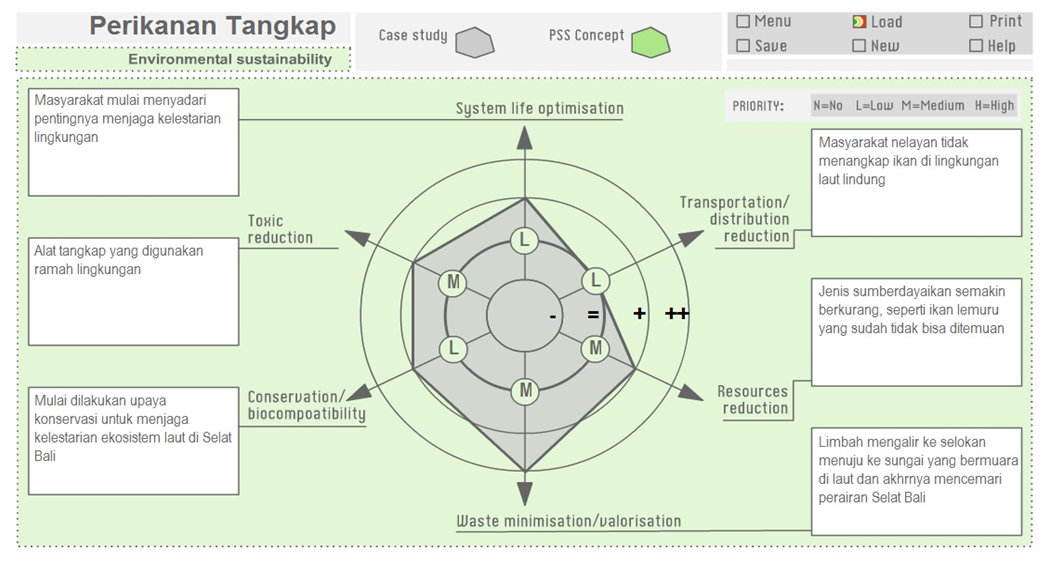 | Figure 3. Sustainability Radar of Environmental Dimension |
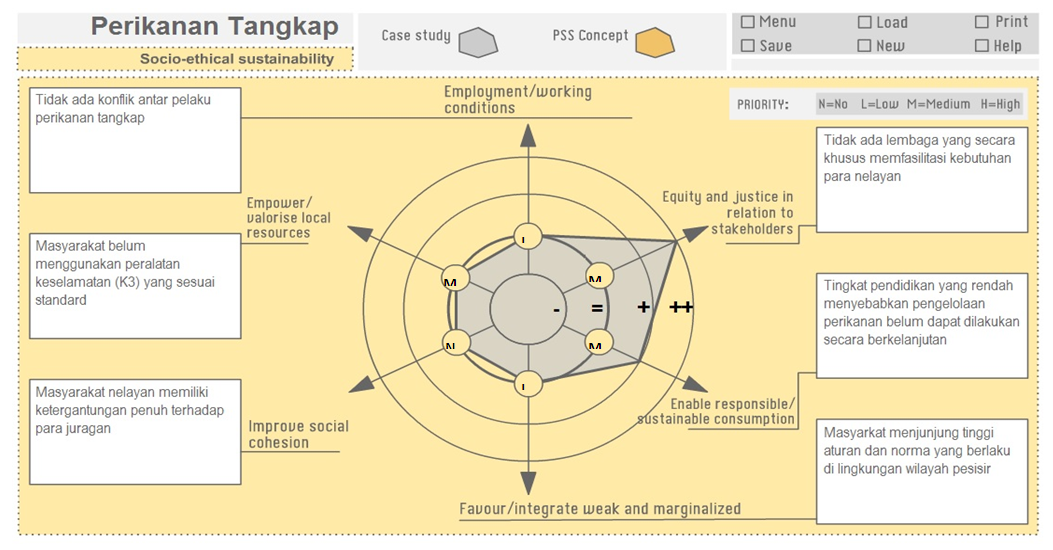 | Figure 4. Sustainability Radar Social Cultural Dimension |
4. Conclusions and Recommendations
- The results of the research concluded that the development of fishery resources in the coastal areas of Banyuwangi has not reached the sustainable stage. This is shown from the results of the calculation of sustainability assessment using the PSS worksheet. The result of measuring the level of sustainability of capture fishery resources that exist in the coastal areas of Banyuwangi shows the average value which is still low. From each dimension (economic, social and environmental) there are several criterias that have medium (M) and high (H) value. This means that in each dimension requires an alternative recommendation to support the sustainable development of capture fisheries.Economic dimension, decreasing catching quantity is a priority of recommendations formulation. The beneficiaries of capture fisheries resources should provide a compensation for conservation measures to maintain the ecosystem. In addition, the government is also an important party which has a role relates to fishery resource policy. The environmental dimension has only one priority of recommendation development, that is making WWTP and its usage according to standard. Better waste management can minimize pollution so will not affect the balance of the ecosystem of fishery resources. For the social dimension, the improvement of institutional system is a recommendation option that can improve the existing fishery resources management system in the coastal areas of Banyuwangi to support the improvement of the welfare of fishermen.The results of this study provide recommendations of the importance of synergy of all levels of society in maintaining the balance of marine ecosystems in the Bali Strait. Increased awareness of coastal communities is needed to maintain the balance of the ecosystem of capture fisheries resources. In addition, improving the quality of human resources of fishermen becomes an important thing that can be done by the government to support the sustainable development of capture fishery resources. Finally, improvements in every aspect of supporting sustainable fisheries development can maintain the sustainability of fishery resources so that the utilization of capture fisheries resources can be done optimally without putting aside economic, environmental and social sustainability.
 Abstract
Abstract Reference
Reference Full-Text PDF
Full-Text PDF Full-text HTML
Full-text HTML